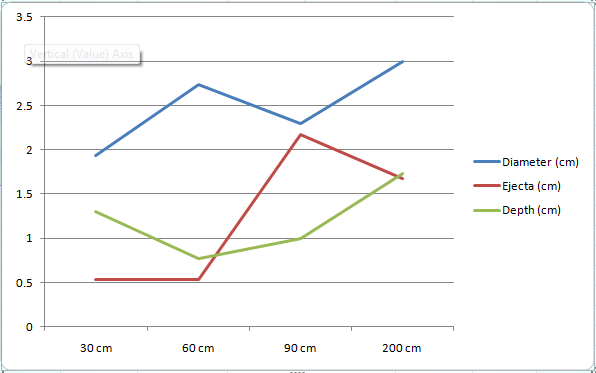Guiding Question: What are the factors that affect the appearance of impact craters? How do scientists use craters to tell the relative age of them?
Hypothesis: I think that the factors that would affect the appearance of craters would be the force/speed with which the meteorite hit the surface and its mass. If a meteor is very small and has no mass, it probably won't make a very large impact on the surface of the moon. If the meteorite does not hit the surface with very much force, it probably won't make that big of an impact, either. (Compared to other meteorites, of course.)
Here is my data table with all the averages of the diameter of the crater, the length of its ejecta, and the depth of the crater:
Here are two different graphs with that information:
Data Analysis:
I think that the higher the "meteor" was from our flour, the bigger and better the craters became. Our diameters went up and down a few times, but in the end, they showed that the higher the meteor, the bigger the impact. My graphs prove that the average height, diameter, and ejecta lengths became larger and deeper. None of them really consistently go up, but all of them are larger on the 200 cm drop than the 30 cm drop.
Conclusion:
I think that I can now answer the question, "What are the factors that impact craters?" The answer is the size of the meteor and how far away it is from the object it hits. If you think about it, my hypothesis was partially correct - I thought that the speed and force with which the meteorite hits the surface would determine the size/shape of the crater. The higher/farther away the meteor is in the first place, the more speed it will gather while traveling through space, and the more force it will have obtained by the time it hits the surface of the moon or some other planet.
Hypothesis: I think that the factors that would affect the appearance of craters would be the force/speed with which the meteorite hit the surface and its mass. If a meteor is very small and has no mass, it probably won't make a very large impact on the surface of the moon. If the meteorite does not hit the surface with very much force, it probably won't make that big of an impact, either. (Compared to other meteorites, of course.)
Here is my data table with all the averages of the diameter of the crater, the length of its ejecta, and the depth of the crater:
Here are two different graphs with that information:
I think that the higher the "meteor" was from our flour, the bigger and better the craters became. Our diameters went up and down a few times, but in the end, they showed that the higher the meteor, the bigger the impact. My graphs prove that the average height, diameter, and ejecta lengths became larger and deeper. None of them really consistently go up, but all of them are larger on the 200 cm drop than the 30 cm drop.
Conclusion:
I think that I can now answer the question, "What are the factors that impact craters?" The answer is the size of the meteor and how far away it is from the object it hits. If you think about it, my hypothesis was partially correct - I thought that the speed and force with which the meteorite hits the surface would determine the size/shape of the crater. The higher/farther away the meteor is in the first place, the more speed it will gather while traveling through space, and the more force it will have obtained by the time it hits the surface of the moon or some other planet.



No comments:
Post a Comment